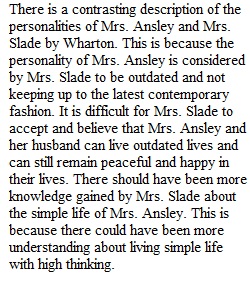


Q Select any two of the following questions and create two critical, thoughtful responses. When crafting your responses, be sure to note the title of the pieces you’re discussing. Use in-text citations from the readings to support your point of view. 1. Find and explicate the passage in “Roman Fever” that you think exemplifies the core irony of the story. 2. Analyze how Wharton characterizes Mrs. Ansley and Mrs. Slade. Pay close attention to how social rivalry and social status are important aspects of their relationship. 3. Lydia tells Ralph, “I don’t want to marry you!” In the paragraph beginning with “Her eyes swam … ” she tells him in more detail why she feels the way she does. Clarify and explain her reasoning and logic on this matter. 4. Fully define the social “pickle” Mrs. Cope puts Lydia in toward the end of Section III of the story. What does this situation make Lydia realize about herself? That is, what does she discover that she desires and values in the social world? 5. Like most of Wharton’s stories, “The Hermit and the Wild Woman” is a psychologically complex narrative. Why do you think she chose the medieval setting for this story? What do the historic and somewhat fantastical setting and characters allow her to do thematically that she could not do as well in a story set in an upper-class New Society? 6. Central themes of “The Hermit and the Wild Woman” revolve around issues of righteousness, purity, pride, and piety. Toward the end of the story, Wharton suggests certain flaws in the Hermit’s character. Describe these flaws and discuss how Wharton presents the Wild Woman in a more positive manner by the story’s end. 7. How has Mrs. Anerton’s relationship with Rendle enriched her life? How has that relationship also thwarted her life? 8. Explain exactly what Mrs. Anerton’s “tragedy” is. Why do you think she cannot bring herself to commit to Danyers? To what extent does Wharton present her refusal of Danyers as a sign of weakness (living in the fantasies of the past) and to what extent is her choice portrayed as a justifiable action? 9. Waythorn comes to perceive himself as a “member of a syndicate” holding a certain number of shares in “his wife’s personality … his predecessors were partners in the business.” Is this feeling of “fragmentation” fair to his wife, her daughter, or her former husbands? 10. “The Other Two” can be read as a comedy of manners. Which lines, passages, or scenes in the story tend to take on a comedic aspect? 11. “The Other Two” is a story about the consequences of divorce. What aspects of divorce does Wharton address in the story and how well does the story register the psychological effects of divorce? 12. Exactly what do you think Andrew Culwin learns about himself in “The Eyes?” Toward the end of the story, he remarks on the appearances of the hideous “eyes”: “Put two and two together if you can. For my part, I haven’t found the link.” As readers, of course, Wharton is positioning us to put two and two together and provide the interpretive “link” that may, or may not be, beyond Culwin’s ability to perceive. So what do the eyes mean? How are they thematically significant and psychologically revealing? 13. Critics have long noted the strong likelihood that Wharton is obliquely depicting homosexuality in “The Eyes.” How do you read Andrew Culwin’s sexual orientation as thematically important in this story? In what ways could Wharton be writing about the consequences of denying one’s sexuality? Make your initial posts by 11:59 p.m. U.S. EST/EDT on Day 4 of Unit 3. Then, review your classmates’ posts and respond to at least three of them. Make your final posts by 11:59 p.m. U.S. EST/EDT on Day 7 of this unit.
View Related Questions